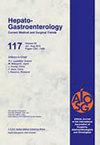Clinical implication of peritoneal cytology in the pancreatic cancer patients who underwent curative resection followed by adjuvant gemcitabine or S-1 chemotherapy.
引用次数: 7
Abstract
BACKGROUND/AIMS The clinical implications of peritoneal lavage cytology (CY) status in the patients who received curative resection and adjuvant chemotherapy have not been established. METHODOLOGY We retrospectively analyzed clinical data from 143 consecutive patients who underwent macroscopically curative resection and received adjuvant gemcitabine or S-1 chemotherapy for pancreatic cancer from 2005 to 2014 in our institution. Correlations between CY status and survival and clinicopathological features were investigated. RESULTS Of the 143 patients, 21 patients were peritoneal washing cytology positive (CY+) (14.7%). Although significant difference was observed in the tumor size, no other correlation between cytology status and clinicopathological parameter existed. The recurrence free survival (RFS) rates at 3 and 5 years after surgery were 5.1% and 0% in CY+ patients, respectively, and were 21.5% and 16.1% in peritoneal washing cytology negative (CY-) patients, respectively, which were significantly different (p=0.001). The OS rates at 3 and 5 years after surgery were 17.1% and 8.6% in CY+ patients, respectively, and were 26.1% and 16.1% in CY- patients, respectively, which were trend to worse in the CY+ patients (p=0.254). CONCLUSION The patients with CY+ are likely to experience recurrence, even after they received curative resection and adjuvant Gemcitabine or S-1 adjuvant chemotherapy.胰腺癌患者行根治性切除后辅助吉西他滨或S-1化疗腹膜细胞学的临床意义。
背景/目的腹膜灌洗细胞学(CY)状态在接受治愈性切除和辅助化疗的患者中的临床意义尚未确定。方法回顾性分析我院2005年至2014年连续143例胰腺癌患者的临床资料,这些患者接受了宏观治愈性切除并辅助接受吉西他滨或S-1化疗。研究CY状态与生存及临床病理特征的相关性。结果143例患者中,腹膜冲洗细胞学阳性21例(14.7%)。虽然在肿瘤大小上观察到显著差异,但细胞学状态与临床病理参数之间不存在其他相关性。CY+组术后3年和5年无复发生存率(RFS)分别为5.1%和0%,CY-组术后3年和5年无复发生存率分别为21.5%和16.1%,差异有统计学意义(p=0.001)。CY+患者术后3年和5年的OS率分别为17.1%和8.6%,CY-患者术后3年和5年的OS率分别为26.1%和16.1%,CY+患者有加重趋势(p=0.254)。结论CY+患者即使在接受根治性切除和辅助吉西他滨或S-1辅助化疗后仍有复发的可能。
本文章由计算机程序翻译,如有差异,请以英文原文为准。
求助全文
约1分钟内获得全文
求助全文
来源期刊

Hepato-gastroenterology
医学-外科
自引率
0.00%
发文量
1
审稿时长
1.9 months
期刊介绍:
Hepato-Gastroenterology has been discontinued as of 2015. Extremely limited quantities of back issues in print available for sale.
 求助内容:
求助内容: 应助结果提醒方式:
应助结果提醒方式:


